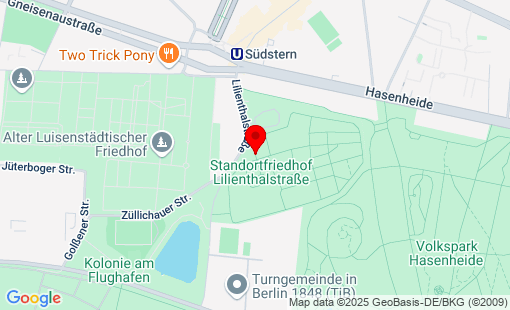Germany
Berlin-Neukölln, Friedhof Lilienthalstraße (Neuer Standortfriedhof)
Total Occupation: 6.185 fatalities
Total Occupation: 6.185 fatalities
Between 1938 and 1941, the new Lilienthalstrasse cemetery was built in the south of Berlin as a burial ground for soldiers. The Army Construction Office was responsible for the planning and implementation. The architect of the ceremonial hall was Wilhelm Büning, who had numerous villas built in Berlin during the Wilhelmine era and was also the architect of the "White City" in Berlin-Reinickendorf (1929-1931) alongside Otto Rudolf Salvisberg, Bruno Ahrends and the garden architect Ludwig Lesser. Klaus Konrad Weber describes Büning's architectural idea in 1981 in "Berlin und seine Bauten" as follows: Through a massive, yet delicate gate, the funeral procession is to leave the realm of the world and of life, ascending a few steps to the monumental ceremonial hall built of ashlars, the temple of the fatherland; its interior is illuminated from above, is thus closed off from the surrounding everyday life, receives its light from higher regions, opens up, as it were, to the spiritual realm. The entire complex is strictly symmetrical. The block-like exterior architecture and the unsurpassable simplicity (but not sobriety) of the interior are both in keeping with the architectural views of early Romanticism as well as the previous phase of Büning's work, albeit under considerably different conditions. A so-called Nazi building that is actually not one, or, if you like, the only one that is not artistically unsuccessful. On May 10, 1940, the inauguration of the new cemetery took place by the Evangelical Field Bishop of the Wehrmacht. Within the cemetery is a cemetery of honor, where the burial of Captain and Squadron Captain Fritz Schleif (1910-1939), who had already been buried with military honors in Königsberg and subsequently transferred to Berlin, took place on the same day. The transfer, burial and care of the graves of the war dead were carried out by the Wehrmacht and were initially free of charge. Until July 1940, around 35 members of the Wehrmacht were buried at the Lilienthalstraße cemetery. However, from April 1941, Wehrmacht burials were also subject to a charge and, as the war progressed, more and more civilians and bombing victims who had died on the "home front" were buried at the Lilienthalstraße cemetery, which was therefore no longer - as originally planned - the central Berlin war cemetery. After the Second World War, representatives of the People's Memorial, which was re-established in Berlin on 22 September 1949, arrived in October 1950. Representatives of the Volksbund Deutsche Kriegsgräberfürsorge e.V. (German War Graves Commission), which was re-established in Berlin on September 22, 1949, and employees of the Department of Horticulture and Green Spaces came together and selected the Lilienthalstraße cemetery, among others, as the main site for war graves in Berlin. Today, 4,935 victims of war and tyranny rest in individual graves in the cemetery and other uncounted war dead in three collective graves, which today cover an area of 1,432 m². Since 2004, the crypt has been home to the sculpture "Caring Woman" by Fritz Cremer (1906-1993), who also created the memorial "O Germany, pale mother" for the Mauthausen concentration camp. On the eve of Remembrance Day, a memorial service with wreath-laying ceremonies is held here, organized by the Volksbund Deutsche Kriegsgräberfürsorge e. V. (German War Graves Commission). Since the mid-1990s, this commemoration has been framed by the German Armed Forces according to protocol and today has the character of an international commemoration ceremony with military attachés and representatives of foreign embassies. Source: Ingolf Wernicke from "Berlin Cemetery Walks"
